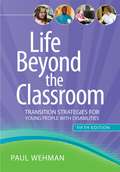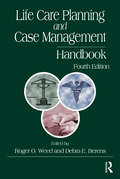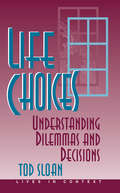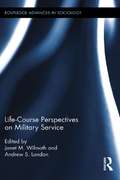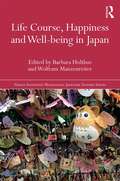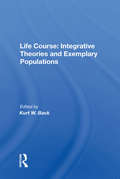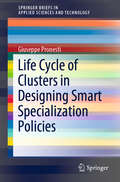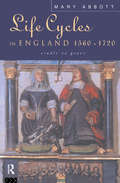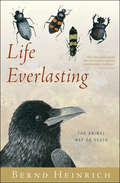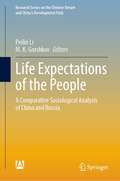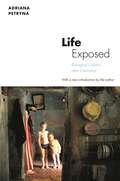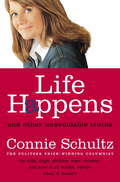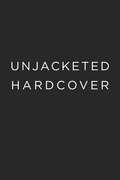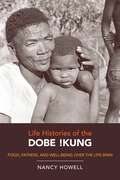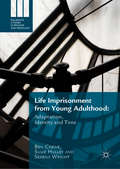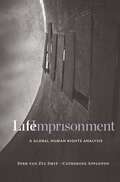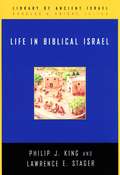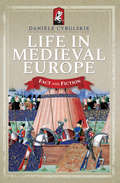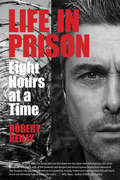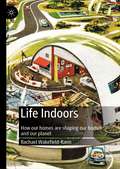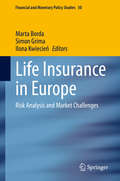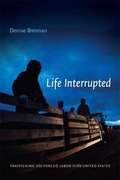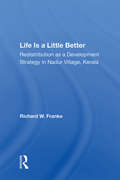- Table View
- List View
Life Beyond the Classroom: Transition Strategies for Young People with Disabilities (Fifth Edition)
by Paul WehmanFor more than two decades, the trusted Life Beyond the Classroom text has shaped the practices of thousands of professionals helping students make a smooth transition from school to adulthood. Now this landmark textbook is in a NEW fifth edition—updated with the cutting-edge information professionals need in today's changing world, as young people with disabilities face unprecedented financial, family, employment, and educational challenges. A definitive compendium of up-to-date, evidence-based transition research, this expanded new edition takes Life Beyond the Classroom to the next level. Future professionals will get all the latest best practices and timely research on the full spectrum of transition topics, from assessment and assistive technology to social skills and self-determination. With this comprehensive revision of a pioneering text, the next generation of professionals will be fully prepared to give young people with disabilities appropriate, effective, and individualized support as they navigate our increasingly complex society. WHAT'S NEW: New chapters on critical topics: working with families multicultural transition planning teaching social skills secondary curriculum options
Life Care Planning and Case Management Handbook
by Roger O. Weed Debra E. BerensLife care planning is an advanced collaborative case management specialty practice focused on assessing, evaluating, coordinating, consulting, planning for, and monitoring necessary services for individuals with complex medical care needs over their lifetime. This handbook provides a comprehensive resource for all people involved with catastrophic impairments and chronic medical care case management. The Life Care Planning and Case Management Handbook, Fourth Edition, begins by defining the roles played by each of the key team members working with the life care planner. It provides planners with insights critical to successful interactions with medical and health care–related professionals as well as the team members they are most likely to encounter as they work to build an accurate and reliable life care plan. Next, the text offers up-to-date information on the medical conditions most frequently encountered by the life care planner. The contributors, who are recognized experts in their disciplines, also address issues in forensic settings, ethics, standards, research, and credentials. The fourth edition includes numerous chapters on general issues, as well as updated standards of practice from the International Academy of Life Care Planners (IALCP), Life Care Planning Consensus Statements, and valuable step-by-step charts and checklists. Completely updated and expanded, this revised handbook now includes new chapters on multicultural considerations in life care planning, admissibility of life care plans in U.S. courts, and Canadian life care planning practice. Additionally, infused in other chapters, is new information on medical coding and costing for life care planners, life care planning in non-litigated contexts, as well as research and education within life care planning.
Life Choices: Understanding Dilemmas and Decisions (Lives in Context)
by Tod Sloan<p>This book may be viewed as an “antiguide” to decisionmaking. It rejects mechanical formulas and urges self-reflection and a critique of ideology. Through close readings of fifteen life history interviews, Tod Sloan creates a framework for the interpretation of dilemmas and decisions. Ultimately, we see that a life choice or turning point comprises three phases—dilemma, deliberation, and decision. As each individual recounts a specific instance when a life choice was necessary, the supporting analysis reveals the framework that triggered the sense that a turning point had been reached. <p>Sloan's basic premise is that common sense and mainstream psychology fail to enlighten us about what is actually involved in major life choices. Individuals tend to make decisions that are not in their best interests and, in fact, these decisions tend to reinforce the sociocultural structures that were initially instrumental in the creation of their dilemmas. By reading the extensive case histories and examining the ways in which the subjects' cultural and social embeddedness interacts with unconscious processes, the reader can develop the ability to understand and think critically about personal life decisions.Developed as an antidote to traditional self-help books, Sloan's decision analysis framework is derived from cognitive, phenomenological, and psychoanalytic theory. Each aspect of the decisionmaking process—from the emergence of a dilemma to postdecision regret—can be understood by considering the contexts of personality, life history, practical arrangements, and ideology.</p>
Life Course Perspectives on Military Service: Life Course Perspectives On Military Service (Routledge Advances in Sociology #83)
by Janet M. Wilmoth Andrew S. LondonThis edited volume provides a comprehensive and critical review of what we know about military service and the life course, what we don’t know, and what we need to do to better understand the role of military service in shaping people's lives. It demonstrates that the military, like colleges and prisons, is a key social institution that engages individuals in early adulthood and shapes processes of cumulative (dis)advantage over the life course. The chapters provide topical synthesizes of the vast but diffuse research literatures on military service and the life course, while the volume as a whole helps to set the agenda for the next generation of data collection and scholarship. Chapter authors pay particular attention to how the military has changed over time; how experiences of military service vary across cohorts and persons with different characteristics; how military service affects the lives of service members’ spouses, children, and families; and the linkages between research and policy.
Life Course, Happiness and Well-being in Japan
by Barbara Holthus Wolfram ManzenreiterMuch of the existing literature on happiness in Japan has been produced in the field of economics and psychology and is quantitative in nature. Here, for the first time, a group of anthropologists and sociologists jointly analyze the state of happiness and unhappiness in Japan among varying social groups in its physical, interpersonal, existential and structural dimensions, offering new insights into fundamental issues. This book investigates the connections between sociostructural aspects, individual agency and happiness in contemporary Japan from a life course perspective. The contributors examine quantitative and qualitative empirical data on the processes that impact how happiness and well-being are envisioned, crafted, and debated in Japan across the life-cycle. Therefore, the book discusses the shifting notions of happiness during people’s lives from birth to death, analyzing the age group-specific experiences while taking into consideration people’s life trajectories and historical changes. It points out recent developments in regards to demographic change, late marriage, and the changing labor market and focuses on their significant impact on the well-being of Japanese people. In particular it highlights the interdependencies of lives within the family and how families are collaborating for the purpose of maintaining or enhancing the happiness of its members. Broadening our understanding of the multidimensionality of happiness in Japan, this book will be of interest to students and scholars of Japanese Studies, Anthropology, and Sociology.
Life Course: Integrative Theories And Exemplary Populations
by Kurt W. BackIn this interdisciplinary study of the human life course as a unit, scholars examine aspects of the life course, looking at several features over a short span and at a few traits over a longer period. provides an overview from disciplines (e.g., history, demography, sociology) that are concerned with understanding the human life course; contains studies of special populations in which integration of a variety of experiences over time can be accomplished. Based on these approaches, new methods appropriate to a science of human life are proposed and discussed in a form suitable for students, faculty, and professionals in human development (sociology, anthropology, psychology), demography, and gerontology.
Life Cycle of Clusters in Designing Smart Specialization Policies (SpringerBriefs in Applied Sciences and Technology)
by Giuseppe PronestìThis book investigates cluster-life-cycle (CLC) analysis to inform the entrepreneurial discovery process (EDP), in order to support the effectiveness of the smart specialization strategy (S3). It focuses on the evolutionary analysis of clusters’ development stages (emergence, development, maturity, decline/transformation), highlighting how different phases of the CLC have a different role in informing S3-policy-making and identifying regions’ potentials to specialize. In so doing, it offers an original conceptual model that explains what information can be provided by CLC analysis in the effective design and implementation of S3 and EDP, systematizes clusters' stage-specific features, and unveils the role played by each CLC stage. It contributes to the emerging academic debate on the role of the CLC concept in policy-making, by highlighting the importance of CLC analysis in dynamically investigating regional contexts and tailoring development policies such as S3. The book is an invaluable resource for academics and regional policy makers, providing them with guidance and recommendations on how to effectively approach the design and implementation of S3 and EDP, by fully tapping the potential of CLC analysis.
Life Cycles in England 1560-1720: Cradle to Grave
by Mary AbbottThis book plots the human career in England, between 1560 and 1720, from birth to old age. It provides a collection of extracts from texts written in the period as well as collection of photographs of images and artefacts made in England between the period.
Life Everlasting: The Animal Way of Death
by Bernd HeinrichAn enlightening look at animal behavior and the cycle of life and death, from &“one of the finest naturalists of our time&” (Edward O. Wilson). When a good friend with a severe illness wrote, asking if he might have his &“green burial&” at Bernd Heinrich&’s hunting camp in Maine, it inspired the acclaimed biologist to investigate a subject that had long fascinated him. How exactly does the animal world deal with the flip side of the life cycle? And what are the lessons, ecological to spiritual, imparted by a close look at how the animal world renews itself? Heinrich focuses his wholly original gaze on the fascinating doings of creatures most of us would otherwise turn away from—field mouse burials conducted by carrion beetles; the communication strategies of ravens, &“the premier northern undertakers&”; and the &“inadvertent teamwork&” among wolves and large cats, foxes and weasels, bald eagles and nuthatches in cold-weather dispersal of prey. Heinrich reveals, too, how and where humans still play our ancient and important role as scavengers, thereby turning not dust to dust, but life to life. &“If it has not been clear to readers by now, this book confirms that Bernd Heinrich is one of the finest naturalists of our time. Life Everlasting shines with the authenticity and originality that are unique to a life devoted to natural history in the field.&” —Edward O. Wilson, author of The Meaning of Human Existence and The Social Conquest of Earth
Life Expectations of the People: A Comparative Sociological Analysis of China and Russia (Research Series on the Chinese Dream and China’s Development Path)
by Peilin Li M. K. GorshkovThis book compares the Chinese and Russian dreams, focusing on eight aspects: prosperity, affluence, family harmony, fairness and justice, diversity, green beauty, honesty and uprightness, and happiness. Based on large-scale survey data combined with the corresponding sociological theory for analysis, it presents detailed information, compelling arguments, and well-founded conclusions, offering insights into the commonalities and differences between these two countries' dreams.
Life Exposed: Biological Citizens after Chernobyl (In-formation Ser.)
by Adriana PetrynaOn April 26, 1986, Unit Four of the Chernobyl nuclear reactor exploded in then Soviet Ukraine. More than 3.5 million people in Ukraine alone, not to mention many citizens of surrounding countries, are still suffering the effects. Life Exposed is the first book to comprehensively examine the vexed political, scientific, and social circumstances that followed the disaster. Tracing the story from an initial lack of disclosure to post-Soviet democratizing attempts to compensate sufferers, Adriana Petryna uses anthropological tools to take us into a world whose social realities are far more immediate and stark than those described by policymakers and scientists. She asks: What happens to politics when state officials fail to inform their fellow citizens of real threats to life? What are the moral and political consequences of remedies available in the wake of technological disasters? Through extensive research in state institutions, clinics, laboratories, and with affected families and workers of the so-called Zone, Petryna illustrates how the event and its aftermath have not only shaped the course of an independent nation but have made health a negotiated realm of entitlement. She tracks the emergence of a "biological citizenship" in which assaults on health become the coinage through which sufferers stake claims for biomedical resources, social equity, and human rights. Life Exposed provides an anthropological framework for understanding the politics of emergent democracies, the nature of citizenship claims, and everyday forms of survival as they are interwoven with the profound changes that accompanied the collapse of the Soviet Union.
Life Happens
by Connie SchultzFrom the 2005 Pulitzer Prize—winning columnist Connie Schultz comes fresh, clever, insightful commentary on life today: love, politics, social issues, family, and much, much more. In the tradition of Anna Quindlen, Molly Ivins, and Erma Bombeck, but with a distinctive voice and sensibility all her own, Connie Schultz comes out of the heartland of America to get you seeing, feeling, and thinking more deeply about the lives we lead today. “You might spot someone you know in the stories here,” writes Connie. “Maybe you’ll even find a glimpse of yourself. Yes, each of us is unique, but life happens in ways that bind us like Gorilla Glue. ” In Life Happens, Connie shares sharp, passionate observations, winning our hearts with personal thoughts on a wide range of topics, from finding love in middle age to the meaning behind her father’s lunch pail, from single motherhood, to who really gets the tips you leave and why as the war in Iraq, race relations, gay marriage, and wwhy women don’t vote. In a more humorous vein, Connie shares her mother’s advice on men (“Don’t marry him until you see how he treats the waitress”) and warns men everywhere against using the dreaded f-word (it’s not the one you think). Along the way, Connie introduces us to the heroic people who populate our world and shows us how just one person can make a difference. Charming, provocative, funny, and perceptive, Life Happens gives us, for the first time, Connie Schultz’s celebrated commentary in one irresistible volume. Life Happens challenges us to be more open and alive to others and to the world around us.
Life Histories of the Dobe !Kung: Food, Fatness, and Well-Being over the Life-Span
by Nancy HowellLife Histories of the Dobe !Kung examines the health, food and nutrition of the Dobe !Kung, the well-known "Bushmen" of the Kalahari Desert.
Life Histories of the Dobe !Kung: Food, Fatness, and Well-being over the Life-span (Origins of Human Behavior and Culture #4)
by Nancy HowellLife Histories of the Dobe !Kung re-examines an important anthropological data set for the Dobe !Kung, the well-known "Bushmen" of the Kalahari Desert, collected by Nancy Howell and colleagues. Using life history analysis, Howell reinterprets this rich material to address the question of how these hunter-gatherers maintain their notably good health from childhood through old age in the Kalahari’s harsh environment. She divides the population into life history stages that correlate with estimated chronological ages and demonstrates how and why they survive, even thrive, on a modest allotment of calories. She describes how surplus food is produced and distributed, and she considers both the motives for the generous sharing she has observed among the Dobe !Kung and some evolutionary implications of that behavior.
Life History Evolution: A Biological Meta-Theory for the Social Sciences
by Steven C. Hertler Aurelio José Figueredo Mateo Peñaherrera-Aguirre Michael A. Woodley of Menie Heitor B. FernandesThe social sciences share a mission to shed light on human nature and society. However, there is no widely accepted meta-theory; no foundation from which variables can be linked, causally sequenced, or ultimately explained. This book advances “life history evolution” as the missing meta-theory for the social sciences. Originally a biological theory for the variation between species, research on life history evolution now encompasses psychological and sociological variation within the human species that has long been the stock and trade of social scientific study. The eighteen chapters of this book review six disciplines, eighteen authors, and eighty-two volumes published between 1734 and 2015—re-reading the texts in the light of life history evolution.
Life Imprisonment from Young Adulthood: Adaptation, Identity and Time (Palgrave Studies in Prisons and Penology)
by Ben Crewe Susie Hulley Serena WrightThis book analyses the experiences of prisoners in England & Wales sentenced when relatively young to very long life sentences (with minimum terms of fifteen years or more). Based on a major study, including almost 150 interviews with men and women at various sentence stages and over 300 surveys, it explores the ways in which long-term prisoners respond to their convictions, adapt to the various challenges that they encounter and re-construct their lives within and beyond the prison. Focussing on such matters as personal identity, relationships with family and friends, and the management of time, the book argues that long-term imprisonment entails a profound confrontation with the self. It provides detailed insight into how such prisoners deal with the everyday burdens of their situation, feelings of injustice, anger and shame, and the need to find some sense of hope, control and meaning in their lives. In doing so, it exposes the nature and consequences of the life-changing terms of imprisonment that have become increasingly common in recent years.
Life Imprisonment in Asia (Palgrave Advances in Criminology and Criminal Justice in Asia)
by Catherine Appleton Dirk van Zyl Smit Giao VucongLife imprisonment is the punishment most often imposed worldwide for what societies regard as the most serious offences. Yet, in Asia the phenomenon has never been studied systematically. Life Imprisonment in Asia fills this major gap. It brings together thirteen new essays on life imprisonment in key jurisdictions in the region. Each chapter consolidates what is known about the law and practice of life imprisonment in the jurisdiction and then explores aspects of the imposition or implementation of life sentences that the authors regard as particularly problematic. In some instances, the main issue is the imposition of life sentences by the courts and their relationship to the death penalty. In others, the focus is on the treatment of life sentenced prisoners. In many instances, the most prominent question is whether life sentenced prisoners should be released and, if so, according to what processes. In the overview chapter, the editors place the complex picture that emerges of life imprisonment in Asia in a global context and point to reforms urgently required to ensure that Asian life sentences meet international human rights standards.Life Imprisonment in Asia should be read by everyone who has an interest in just punishments for serious offences, not only in Asia, but throughout the world. It will be an invaluable tool for lawyers, criminologists, policy makers and penal reform advocates in the region and beyond.
Life Imprisonment: A Global Human Rights Analysis (Oñati International Series In Law And Society Ser.)
by Dirk van Zyl SmitLife imprisonment has replaced the death penalty as the most common sentence imposed for heinous crimes worldwide. Consequently, it has become the leading issue of international criminal justice reform. In the first survey of its kind, Dirk van Zyl Smit and Catherine Appleton argue for a human rights–based reappraisal of this harsh punishment.
Life In Biblical Israel
by Philip King Lawrence StagerThis special-edition volume of the Library of Ancient Israel, based on the latest research, presents a vivid description of the world of Ancient Israel, covering such topics as domestic life, the means of existence, cultural expression, and religious practices. With over 175 full-color pictures and illustrations,Life in Biblical Israelopens the door to everyday life in biblical Israel for all readers. This volume is perfect for classrooms, coffee tables, and personal use. <p><p> Volumes in the Library of Ancient Israel draw on multiple disciplines--such as archaeology, anthropology, sociology, linguistics, and literary criticism--to illuminate the everyday realities and social subtleties these ancient cultures experienced. This series employs sophisticated methods resulting in original contributions that depict the reality of the people behind the Hebrew Bible and interprets these insights for a wide variety of readers.
Life In Medieval Europe: Fact and Fiction
by Danièle Cybulskie&“A lovely, witty treasure trove of a book, spilling over with historical gems . . . a very human history: sometimes weird, always wonderful.&” —Dan Jones, New York Times-bestselling author Have you ever found yourself watching a show or reading a novel and wondering what life was really like in the Middle Ages? What did people actually eat? Were they really filthy? And did they ever get to marry for love? In Life in Medieval Europe: Fact and Fiction, you&’ll find fast and fun answers to all your secret questions, from eating and drinking to sex and love. Find out whether people bathed, what they did when they got sick, and what actually happened to people accused of crimes. Learn about medieval table manners, tournaments, and toothpaste, and find out if people really did poop in the moat. &“To say that this book was fun to read would be an understatement. Cybulskie&’s knowledge radiates in every page of this short book . . . It was educational and entertaining all at the same time. Simply a wonderful resource for novice medievalists and writers of historical fiction and nonfiction alike.&” —Adventures of a Tudor Nerd &“All in all, this is an excellent book to put to bed many of the myths surrounding medieval existence that persist in the popular imagination. Easy to read and well worth the time to read it. I highly recommend this book if you want to get a mostly unbiased view of medieval life.&” —Battles and Book Reviews
Life In Prison: Eight Hours at a Time
by Robert Reilly<P> In this gripping nonfiction account, Robert Reilly provides a look inside America’s prison system unlike any other, and the way that it affects not only the prisoners themselves but also the corrections officers and their families. <P> After 13 years of struggling in the music business, Robert Reilly found himself broke and on the edge of despair. The specter of success in the music business had become a monster about to ruin his family life. Something had to change, or something was going to break beyond repair. <P> A chance conversation with a neighbor led him to apply, somewhat half-heartedly, for a job at the county prison. Although he hated the thought of a “real job,” a regular salary of $40,000 with benefits, and paid time off seemed like a small fortune. “Amazingly, I somehow got hired. So, in an effort to do the right thing and put my family first, I left the madness of the music business and entered the insanity of the U.S. prison system.” <P> Robert Reilly served a seven-year term as a prison guard in Pennsylvania and Maine. Entering America’s industrial prison system in search of a way to support his young family, the struggling musician found himself in a looking-glass world where, often, only the uniforms distinguished guards from prisoners. Life in Prison chronicles the horrors of a place where justice is arbitrary, outcomes are preordained, and the private sector makes big money while the public looks away. This is Reilly’s story of doing time. <P> To call the experience sobering would be the ultimate understatement: “As time crawls by, I become jealous of the inmates leaving the prison. I start to slip; I start to feel like I’m losing my faith. Any trace of innocence that I thought I still had starts to evaporate. I begin to feel trapped, imprisoned, locked in a dark heartbreaking world, just like an inmate.” <b> *Silver Medal, 2015 IBPA Benjamin Franklin Awards, Best New Voice**Finalist, Memoir, 2015 Maine Literary Award* </b>
Life Indoors: How our homes are shaping our bodies and our planet
by Rachael Wakefield-RannIn this timely and expansive book, Wakefield-Rann investigates how emerging disease ecologies are undermining definitions of health and immunity that have persisted since the 19th century, and had a formative influence over the design of not only homes, but entire cities. This wide-ranging account traces the links between the history of medicine, modernist design and architecture, the rise of inflammatory disease, the microbiomes of buildings and humans, antimicrobial resistance, and novel chemical pollutants, to show how indoor environments have made us as we have made them. In highlighting the processes that have been missed in designing perfectly controlled interior habitats, Life Indoors shows the limitations of dominant practices, classifications and philosophies to apprehend current indoor pathogen ecologies.
Life Insurance in Europe: Risk Analysis and Market Challenges (Financial and Monetary Policy Studies #50)
by Simon Grima Marta Borda Ilona KwiecieńThis book examines the challenges for the life insurance sector in Europe arising from new technologies, socio-cultural and demographic trends, and the financial crisis. It presents theoretical and applied research in all areas related to life insurance products and markets, and explores future determinants of the insurance industry’s development by highlighting novel solutions in insurance supervision and trends in consumer protection. Drawing on their academic and practical expertise, the contributors identify problems relating to risk analysis and evaluation, demographic challenges, consumer protection, product distribution, mortality risk modeling, applications of life insurance in contemporary pension systems, financial stability and solvency of life insurers. They also examine the impact of population aging on life insurance markets and the role of digitalization. Lastly, based on an analysis of early experiences with the implementation of the Solvency II system, the book provides policy recommendations for the development of life insurance in Europe.
Life Interrupted: Trafficking into Forced Labor in the United States
by Denise BrennanLife Interrupted introduces us to survivors of human trafficking who are struggling to get by and make homes for themselves in the United States. Having spent nearly a decade following the lives of formerly trafficked men and women, Denise Brennan recounts in close detail their flight from their abusers and their courageous efforts to rebuild their lives. At once scholarly and accessible, her book links these firsthand accounts to global economic inequities and under-regulated and unprotected workplaces that routinely exploit migrant laborers in the United States. Brennan contends that today's punitive immigration policies undermine efforts to fight trafficking. While many believe trafficking happens only in the sex trade, Brennan shows that across low-wage labor sectors--in fields, in factories, and on construction sites--widespread exploitation can lead to and conceal forced labor. Life Interrupted is a riveting account of life in and after trafficking and a forceful call for meaningful immigration and labor reform.All royalties from this book will be donated to the nonprofit Survivor Leadership Training Fund administered through the Freedom Network.
Life Is A Little Better: Redistribution As A Development Strategy In Nadur Village, Kerala
by Richard W FrankeThis ethnography of Nadur Village explores the ramifications of Kerala State's policy of wealth redistribution to achieve equality. The author shows a decline in income inequality and an improved quality of life for most villagers despite high unemployment, low incomes and the persistence of inequalities that redistribution has not overcome. This e
